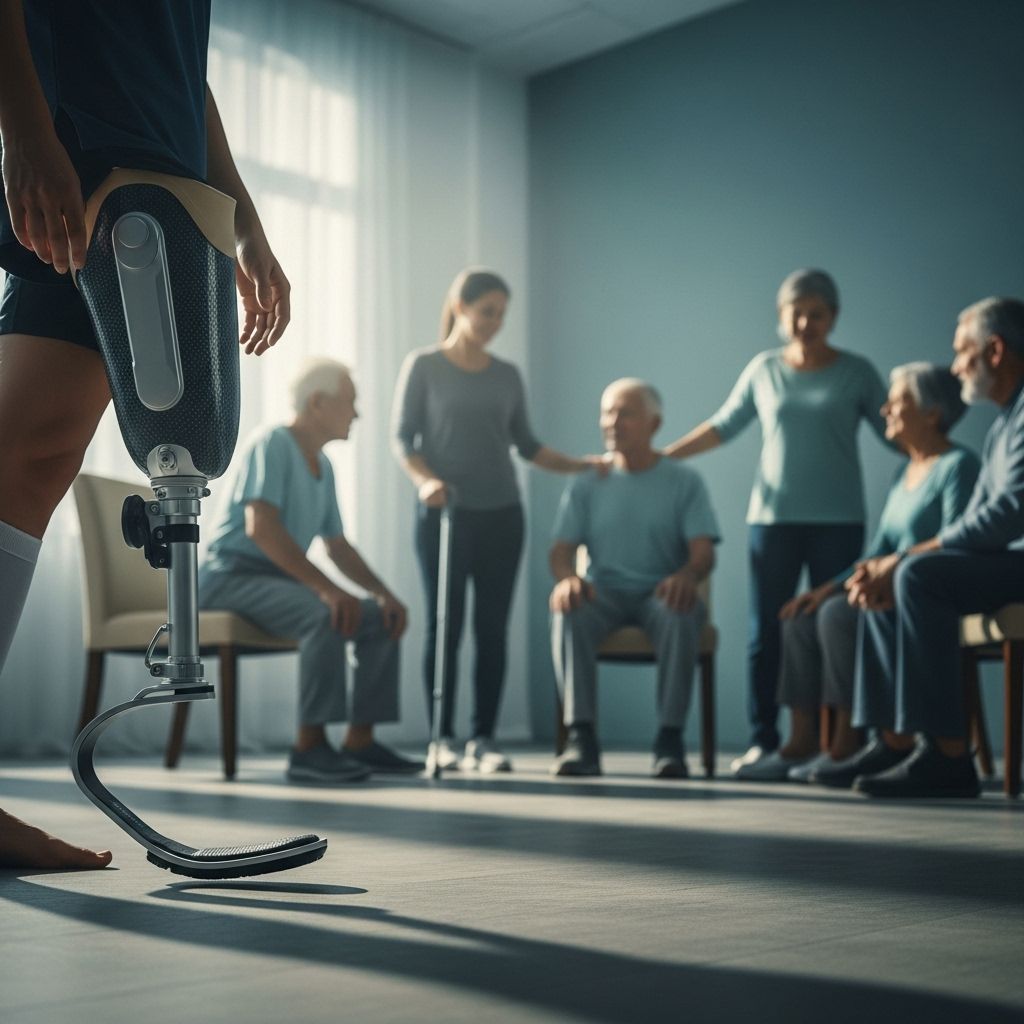Understanding Amputation: Causes, Procedures, Risks, Recovery, and Long-Term Care
Comprehensive guide to amputation: from causes and surgical process to recovery, rehabilitation, and living with limb loss.

Amputation: A Comprehensive Guide
Amputation is the surgical removal of a limb or part of a limb, often necessary to save or improve patient’s health when a body part is severely damaged, diseased, or threatens the person’s well-being. This extensive guide covers the reasons for amputations, the procedure itself, key risks, essentials of recovery, rehabilitation, emotional health, and the lifelong journey after amputation.
What is Amputation?
An amputation is a surgical procedure where a limb or portion of a limb is removed from the body. This major operation is often performed to treat severe trauma, infection, chronic disease, or to alleviate pain and suffering when other therapies have failed. While most commonly associated with arms and legs, amputation can involve any body part such as fingers, toes, hands, and feet.
Reasons for Amputation
Several medical conditions and circumstances may necessitate an amputation procedure. The underlying causes generally fall into the following categories:
- Severe trauma or injury: Including crush injuries, accidents, war injuries, or severe burns.
- Blood vessel diseases: Such as peripheral arterial disease, which can severely reduce blood supply, leading to tissue death.
- Infections: Uncontrolled or spreading infections, particularly when resistant to antibiotics.
- Cancer: Tumors in bones or muscles that do not respond to other treatments may require amputation.
- Congenital limb defects: Some individuals are born with absent or nonfunctional limbs requiring amputation and fitting with prosthetics.
- Other causes: Frostbite, diabetes-related complications (such as gangrene or non-healing ulcers), or complications from previous surgeries.
Common Sites of Amputation
- Leg (above or below the knee)
- Foot or toes
- Arm (above or below the elbow)
- Hand or fingers
Preparing for an Amputation
The decision to amputate is made through a careful process involving multiple medical specialists, often forming a multidisciplinary team comprising surgeons, rehabilitation physicians, nurses, physical and occupational therapists, prosthetists, psychologists, and social workers. Patient education and involvement in decision-making are prioritized, as the operation brings lasting changes to quality of life and daily activity.
Pre-Surgical Assessment and Planning
- Physical evaluation: Detailed assessment of the affected limb, general health, any underlying conditions, and factors influencing recovery (age, comorbidities).
- Imaging tests: Such as X-rays, MRI, or CT scans to determine the extent of disease or injury.
- Blood tests: To check for infection and overall fitness for surgery.
- Patient counseling: Information on surgical process, possible complications, rehabilitation, and emotional preparation.
- Pain management planning: Anticipating pain control needs post-surgery.
- Prosthetic evaluation: Referral to a prosthetist may happen before surgery to discuss future fitting options.
The Amputation Procedure
While the details can differ based on the level and location of amputation, the typical steps of the operation include:
- Administration of anesthesia (general or regional)
- Removal of the affected bone and tissue, preserving as much healthy tissue as possible
- Sealing blood vessels and nerves to prevent bleeding and pain
- Shaping of muscles and skin to create a healthy, cushioned stump suitable for prosthetic use
- Closure of the wound, occasionally using skin grafts if needed
- Dressing and placement of drains if required to prevent fluid collection
Types and Levels of Amputation
Common amputation levels include:
- Below-Knee (Transtibial): Preserves the knee joint, important for mobility and prosthetic fitting.
- Above-Knee (Transfemoral): More energy-intensive to walk after, but sometimes necessary if lower leg cannot be preserved.
- Below-Elbow (Transradial) or Above-Elbow (Transhumeral): For upper limb loss.
- Partial amputation: Such as removal of toes, fingers, or part of a hand/foot.
Risks and Possible Complications
As with any surgical procedure, amputation carries certain risks, which may include:
- Bleeding or hematoma formation
- Infection of the surgical site
- Poor wound healing (more common in people with vascular disease or diabetes)
- Blood clots (deep vein thrombosis, pulmonary embolism)
- Phantom limb sensations (feeling pain or sensation in the absent limb)
- Contractures (stiffening of nearby joints or muscles)
- General anesthesia risks
Recovery After Amputation
Recovery from amputation is a process that involves both physical and emotional adaptation. Hospital stays vary based on the operation’s severity, overall health, and complications. Initial days focus on wound care, infection prevention, and pain management, usually with medications and occasionally through regional nerve blocks.
Immediate Postoperative Care
- Pain management: Essential for healing and comfort, may involve medications, nerve blocks, or other techniques.
- Wound care: Monitoring for infection, proper bandaging, drainage, and early healing.
- Early movement: Gentle movements as soon as possible to help prevent clots and lung problems.
- Mental health support: Counseling for emotional adjustment, including post-surgical shock, grief, and risk of anxiety or depression.
Stages of Recovery
| Stage | Key Focus |
|---|---|
| Immediate Postoperative | Pain control, wound care, emotional support |
| Early Rehabilitation | Physical therapy, stump shaping, psychological adaptation |
| Prosthetic Fitting | Custom fitting, learning prosthesis use |
| Return to Daily Life | Occupational therapy, home adjustments, lifestyle planning |
Rehabilitation After Amputation
Rehabilitation is central to regaining independence. A specialized rehabilitation team coordinates care, aiming to maximize function, mobility, and psychological adaptation.
Key Components of Rehabilitation
- Physical therapy: Exercises to strengthen muscles, improve balance, and prevent complications in the residual limb.
- Occupational therapy: Strategies and equipment for resuming daily tasks and maximizing independence.
- Prosthesis training: Learning to use artificial limbs, which may involve gradual fitting and adjustments.
- Emotional and psychological support: Addressing grief, adapting to body image changes, coping with new challenges.
- Education for patient and family: On wound care, prosthetic maintenance, lifestyle changes, and long-term health.
Psychological Adaptation and Support
The mental and emotional impact of amputation can be profound. Psychological responses often include shock, grief, anxiety, depression, and concerns about social acceptance and return to work. Effective interventions include:
- Motivational enhancement therapy and solution-focused brief therapy: To set achievable goals and build self-efficacy.
- Cognitive Behavioral Therapy (CBT): For changing maladaptive thoughts, coping with pain and altered body image.
- Mindfulness meditation: To reduce pain perception and negative emotions, increase life satisfaction.
- Acceptance and Commitment Therapy (ACT): To improve adaptation by embracing acceptance and focusing on meaningful actions even with limitations.
- Family support: Involving family members in counseling can help them manage their own emotional responses and better support the patient.
Prosthetics and Assistive Devices
A prosthesis is an artificial device fitted to replace a missing limb. Not every patient will use a prosthetic limb, but for many, prosthetics are essential for regaining mobility and independence.
Types of Prosthetic Limbs
- Lower-limb prosthetics: For above and below-knee amputations, featuring sockets, pylons, joints, and custom-fit feet.
- Upper-limb prosthetics: Including options for hands, arms, and fingers—can be aesthetic, functional, or robotic/myoelectric.
Prosthetic training is important for learning to walk, grip, balance, and perform daily tasks. Regular adjustments and maintenance ensure a comfortable fit as the residual limb changes over time.
Long-term Care and Life After Amputation
Amputation is the beginning of a lifelong adjustment. Comprehensive, ongoing care is critical for optimal quality of life. Key long-term considerations include:
- Continued medical follow-up: Regular visits to evaluate limb health, prosthetic fit, and monitor for secondary complications.
- Monitoring for re-amputation: Individuals are at higher risk for additional amputations due to underlying diseases like diabetes and peripheral artery disease.
- Secondary conditions: Amputees are more likely to develop knee osteoarthritis (if one limb bears more weight), low back pain, and other musculoskeletal issues.
- Peer support: Engaging with other amputees helps with emotional adaptation and problem-solving.
- Lifelong rehabilitation: Physical therapy, adaptive strategies, and sometimes further surgeries are necessary as needs change.
Potential Complications and Challenges
- Phantom limb pain: A common phenomenon where sensation or pain is felt in the limb that is no longer present. Various therapies exist to manage this unique pain.
- Residual limb pain: Pain at the stump site could be from nerve damage, poor prosthetic fit, or ongoing disease. It requires prompt evaluation.
- Infection and skin problems: The residual limb must be kept clean, dry, and checked for sores, blisters, or infections.
- Contractures: Tightening of joints and muscles may impair future prosthetic fitting and mobility if not managed with regular exercise and stretching.
- Adjustment to prosthesis: Time and graded exposure are needed to adapt to using artificial limbs safely and effectively.
Lifestyle, Employment, and Social Reintegration
Many people with amputations regain high levels of mobility and independence. Returning to work, engaging in hobbies, sports participation, and social activities are achievable goals.
- Home modifications: May be necessary for accessibility and safety (e.g., ramps, grab bars, adaptive devices).
- Workplace accommodations: Occupational therapy can advise on modifications and adaptive equipment for resuming employment.
- Support groups: Offer practical and emotional assistance, sharing stories and solutions.
- Ongoing education: About health maintenance, fall prevention, skin care, and adapting to new technologies.
FAQs: Amputation
Q: What are the main reasons someone might need an amputation?
A: Common causes include severe injury, vascular diseases like diabetes, uncontrolled infection, cancer, and congenital defects.
Q: What can be expected during recovery after an amputation?
A: Recovery involves wound healing, pain management, physical therapy, psychological support, and potential prosthetic fitting. The ultimate goal is returning to independence and daily life.
Q: Is phantom limb pain real? How is it managed?
A: Yes, phantom limb pain is a real and common phenomenon. Management may include medications, nerve therapies, mirror therapy, and psychological support.
Q: Will everyone who has an amputation use a prosthesis?
A: Not always. The decision depends on the person’s health status, level of amputation, lifestyle goals, and preferences. Some adapt to assistive devices other than prosthetics.
Q: Does amputating a limb cure the underlying disease?
A: No. While amputation may be necessary to control life-threatening conditions, ongoing care and treatment of underlying diseases, such as diabetes or vascular disease, are critical to prevent additional complications or further amputations.
References
- https://pmc.ncbi.nlm.nih.gov/articles/PMC8225497/
- https://pure.johnshopkins.edu/en/publications/multidisciplinary-amputation-team-management-of-individuals-with-
- https://pure.johnshopkins.edu/en/publications/rehabilitation-of-individuals-with-limb-loss-due-to-trauma
- https://publichealth.jhu.edu/2002/leg-injuries
- https://www.hopkinsguides.com/hopkins/view/Johns_Hopkins_Diabetes_Guide/547006/all/Amputations?q=diabetes+hospital+management
Read full bio of medha deb












